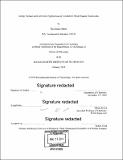Energy storage and conversion applications of conductive metal-organic frameworks
Author(s)
Miner, Elise Marie.
Download1103440782-MIT.pdf (22.62Mb)
Other Contributors
Massachusetts Institute of Technology. Department of Chemistry.
Advisor
Mircea Dincă.
Terms of use
Metadata
Show full item recordAbstract
Establishing catalytic structure-function relationships enables optimization of the catalyst structure for enhanced activity, selectivity, and durability against reaction conditions and prolonged catalysis. One class of catalysts that could benefit from systematic optimization is non-platinum group metal (non-PGM) electrocatalysts for the O₂ reduction reaction (ORR) to water (4e⁻ reduction) and / or hydrogen peroxide (2e⁻ reduction). The electrically conductive metal-organic frameworks (MOFs) M₃(HXTP)₂ (HXTP = 2,3,6,7,10,11-hexaimino or hexahydroxytriphenylene (HITP or HHTP, respectively)) feature a crystalline structure that contains homogeneously distributed, square planar transition metal sites reminiscent of those doped into carbonaceous media for ORR catalysis. Ni₃(HITP)2 functions as an active and stable ORR electrocatalyst in alkaline medium. Experimental and computational techniques enabled elucidation of the kinetics, mechanism, and active site for ORR with Ni₃(HITP)₂, as well as understanding the essential nature of the extended MOF structure in providing catalytic activity. Varying the metal and ligand combinations within this class of MOFs afforded two distinct phases. Probing the stability, catalytic activity, product distribution, and electronic properties of the two phases of MOFs identified phase-dependent catalytic activity, regardless of the metal or chelating atom identity. Since the birth of the first rechargeable battery in 1860, emerging battery technologies have both provided answers to energy demands as well as additional obstacles to navigate. Recent works have explored using MOFs as ionically conductive solid-state electrolytes which would eliminate the need for volatile organic liquids and potentially offer a wider electrolyte potential window and means of controlling the plating of alkali metals during charging. This work has taken advantage of the modular charge found in a Cu-azolate MOF, wherein guest Cl⁻ ions coordinated to Cu₄-lined clusters can be washed out of the structure, and stoichiometric loadings of anions varying in size can be reconstituted into the MOF when soaking the MOF in solutions containing alkali or alkaline earth metal salts. The anions are held in place through coordination to the Cu²⁺ centers, thus enabling the charge-balancing metal cations to achieve high transference numbers within this solid electrolyte. Further, the versatility regarding the identity of the guest metal salt provides a handle for modulating the cation transport activation energy and ionic conductivity.
Description
Thesis: Ph. D., Massachusetts Institute of Technology, Department of Chemistry, 2019 Cataloged from PDF version of thesis. Includes bibliographical references (pages 182-200).
Date issued
2019Department
Massachusetts Institute of Technology. Department of ChemistryPublisher
Massachusetts Institute of Technology
Keywords
Chemistry.